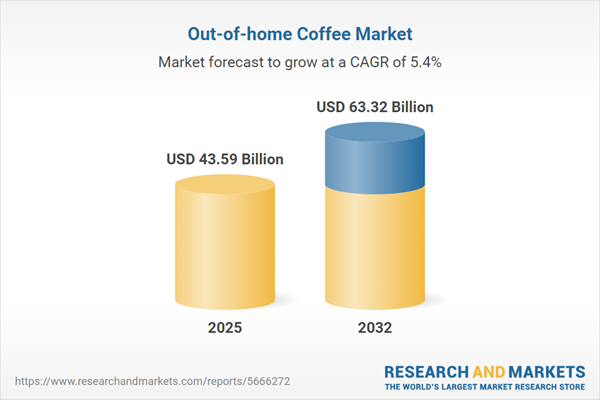Speak directly to the analyst to clarify any post sales queries you may have.
The out-of-home coffee market is undergoing substantial transformation as operators respond to technology shifts, changing consumer habits, and evolving urban environments. Senior decision-makers who adapt proactively can capture emerging opportunities and strengthen their organization’s competitive position in the sector.
Market Snapshot: Global Out-of-Home Coffee Market
The global out-of-home coffee market stands at USD 41.48 billion, with the sector projected to reach USD 43.59 billion in annual growth and a total value of USD 63.32 billion by 2032. Growth drivers include accelerating urbanization, rising demand for convenient solutions, and consumer preference for premium, specialized coffee experiences. Industry participants are modernizing retail formats, investing in customer engagement models, and refining service delivery to capture new demographics and build long-term loyalty in an increasingly saturated marketplace.
Comprehensive Scope & Segmentation of the Out-of-Home Coffee Market
This report delivers actionable segmentation for leaders managing the complex out-of-home coffee landscape. In-depth analysis of each segment supports precise investment, granular forecasting, and focused expansion across diverse regions and consumer groups.
- Product Types: Brewed coffee, espresso, cold brew, specialty drinks, instant blends, and plant-based choices appeal to distinct demographic and geographic profiles, helping brands devise tailored offerings for evolving consumer needs.
- Service Models: Catering, dine-in, drive-thru, takeaway, and home delivery formats address urban and suburban consumer patterns, giving operators enhanced flexibility to serve varied markets efficiently.
- Ordering Methods: Walk-in experiences, digital ordering—via both proprietary and third-party platforms—and self-service kiosks foster seamless, contactless consumer journeys to enhance satisfaction and throughput.
- Ownership Structures: Chain-operated and independent venues enable operators to maintain brand distinction, market agility, and deep local relevance amid rapidly changing consumer trends.
- Distribution Channels: Cafés, independent coffeehouses, restaurants, vending locations, in-store coffee corners, and office delivery channels support market penetration while broadening both reach and accessibility for new and existing customers.
- Regional Coverage: The report examines major regions including North America, South America, Europe, the Middle East, Africa, and Asia-Pacific, providing focused insights into countries such as the US, UK, Germany, China, India, Brazil, Canada, and the UAE for region-specific strategy development.
- Company Analysis: Detailed profiles of Starbucks, Nestlé, Pret A Manger, Keurig Dr Pepper, Cafe Coffee Day, and Tim Hortons reveal diverse approaches to operational efficiency and innovation, supporting best practices and leadership resiliency.
This segmentation equips teams to deploy resources strategically, integrate advanced technologies effectively, and shape go-to-market strategies that reflect both local and global trends.
Key Strategic Takeaways for Senior Decision-Makers
- Flexible coffee venues with multi-purpose layouts deepen customer interaction, creating spaces that cater to both social gatherings and productive work sessions.
- Digital platforms—covering ordering, loyalty, and labor analytics—unlock new engagement channels and support data-driven operational improvements.
- Commitment to sustainability through responsible sourcing and eco-focused packaging fosters institutional trust and long-term stakeholder value.
- Broadening product portfolios to include plant-based and innovative cold options responds to evolving consumer tastes and supports both market expansion and diversification.
- Regional supplier partnerships improve sourcing agility, foster menu customization, and help organizations quickly address market shifts and local consumption drivers.
- Adapting service models to local and cultural preferences maximizes regional relevance and strengthens global market positioning.
Tariff Impact on Supply Chains and Pricing
Recent changes to tariffs are challenging operators to revise procurement strategies. Building strong supplier relationships, innovating in roasting and packaging, and introducing adaptable sourcing frameworks have become essential for price management and maintaining supply chain continuity.
Methodology & Data Sources
This research utilizes a comprehensive methodology combining executive interviews, barista perspectives, large-scale consumer surveys, and expert sector analysis. This multi-source approach delivers timely and relevant insights for senior leaders focused on strategic planning in the out-of-home coffee sector.
Why This Report Matters for Senior Coffee Leaders
- Accelerates digital transformation and supports efficient investment allocation in both established and emerging coffee markets.
- Enables agile risk management via actionable intelligence on sustainability, sourcing, and product innovation, helping leadership teams adapt decisively to dynamic trends.
- Aligns organizational direction with changing customer behavior, unlocking new opportunities for growth and market entry strategies tailored to out-of-home coffee demand.
Conclusion
This report empowers decision-makers to anticipate challenges, innovate proactively, and support scalable growth as the out-of-home coffee market evolves.
Additional Product Information:
- Purchase of this report includes 1 year online access with quarterly updates.
- This report can be updated on request. Please contact our Customer Experience team using the Ask a Question widget on our website.
Table of Contents
3. Executive Summary
4. Market Overview
7. Cumulative Impact of Artificial Intelligence 2025
Companies Mentioned
The companies profiled in this Out-of-home Coffee market report include:- Columbus Café & Co
- Cafe Coffee Day
- Asahi Group Holdings, Ltd.
- Atomic Brands
- Blue Tokai Coffee Roasters
- Continental Coffee Private Limited
- Inspire Brands
- JAB Holding Company Sàrl
- Keurig Dr Pepper Inc.
- Lotte Corporation
- Luigi Lavazza S.p.A.
- Matthew Algie & Company Ltd.
- McDonald's Corporation
- MTPak Coffee
- Nestlé S.A.
- Peet's Coffee
- Pret A Manger
- Rage Coffee
- Scooter's Coffee
- Starbucks Corporation
- Tchibo GmbH
- The Coca-Cola Company
- The JM Smucker Company
- The Kraft Heinz Company
- Tim Hortons Inc.
Table Information
| Report Attribute | Details |
|---|---|
| No. of Pages | 191 |
| Published | November 2025 |
| Forecast Period | 2025 - 2032 |
| Estimated Market Value ( USD | $ 43.59 Billion |
| Forecasted Market Value ( USD | $ 63.32 Billion |
| Compound Annual Growth Rate | 5.4% |
| Regions Covered | Global |
| No. of Companies Mentioned | 26 |









